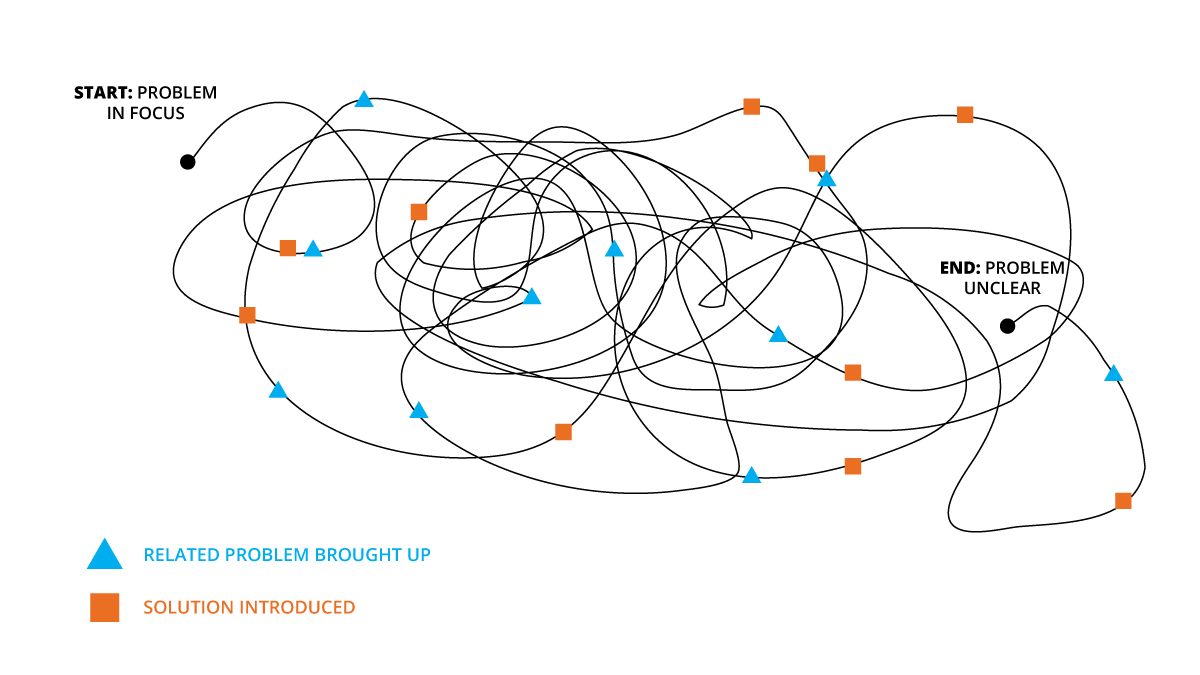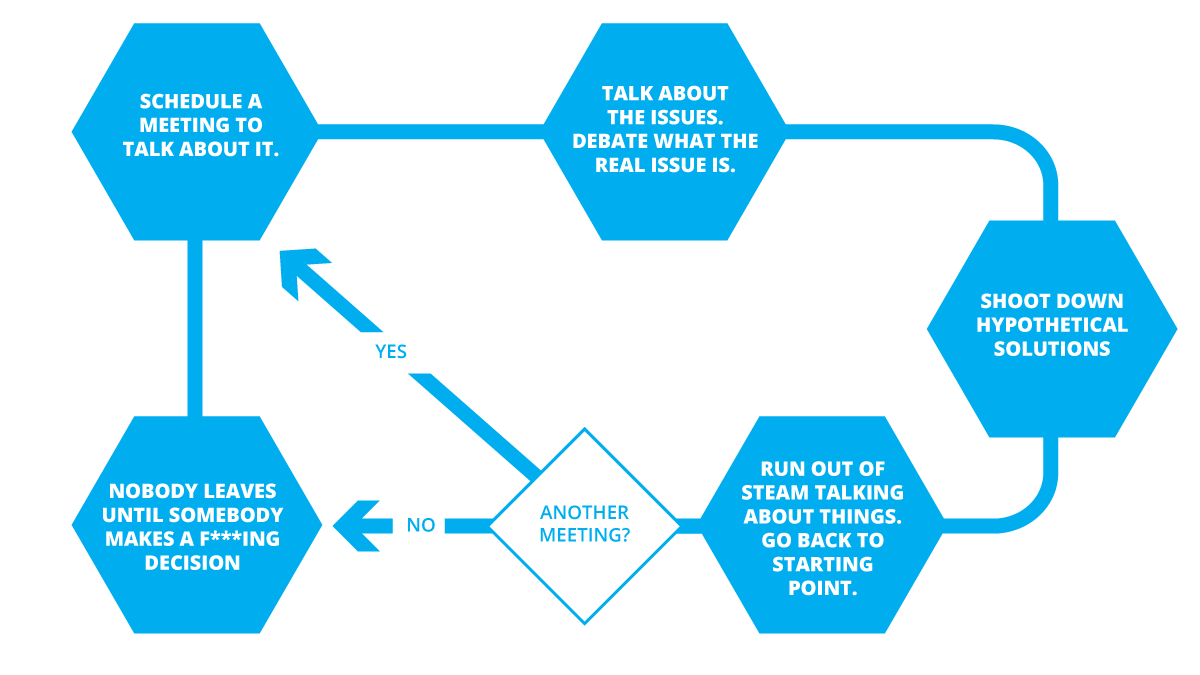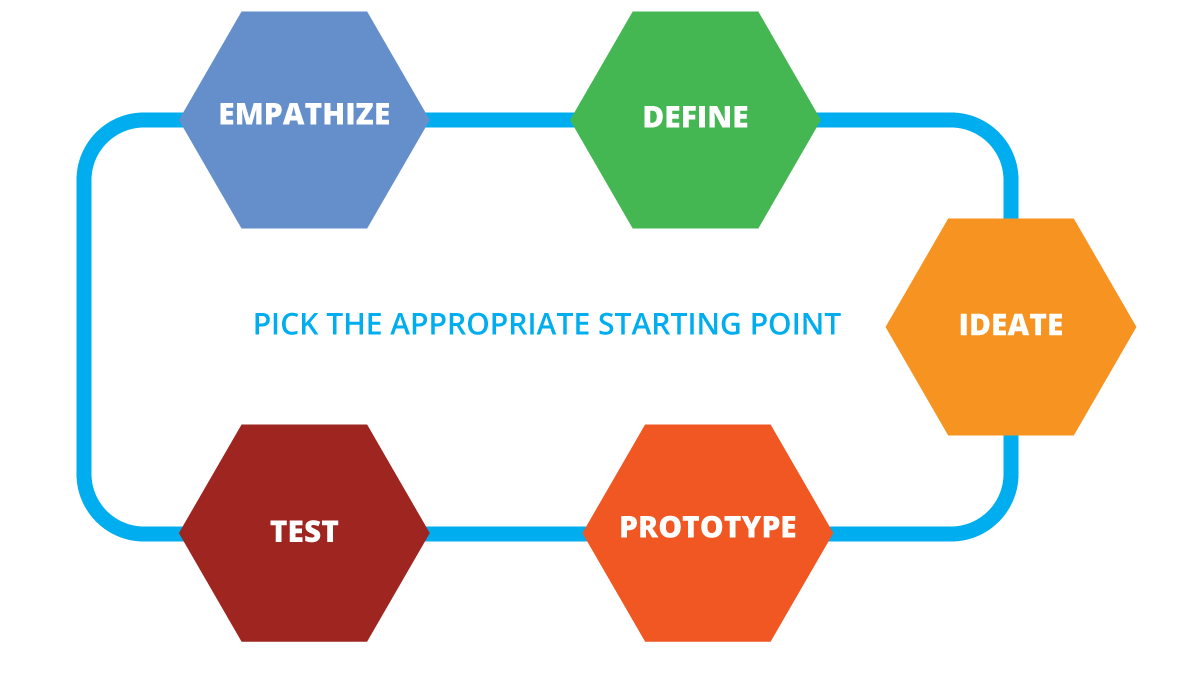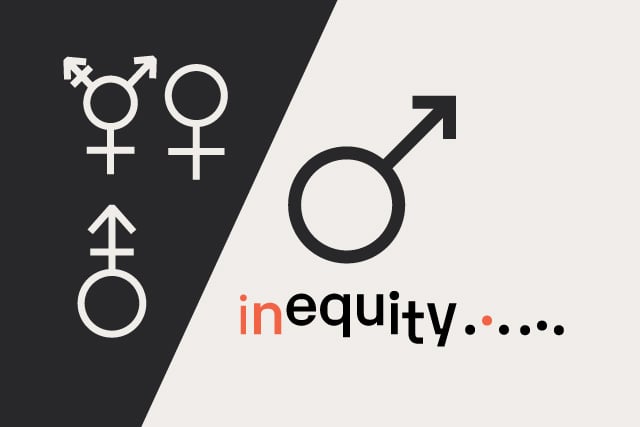Solving Organizational Problems with Design Thinking
Dennis Kardys Director of Design & Production#Digital Strategy

Believe it or not, a three-hour roundtable discussion is not the best way to collaborate on solutions to big organizational problems. Diagram's Dennis Kardys shares how the Design Thinking framework can help you work more effectively across teams and departmental silos.
If you're using roundtable discussions as the primary means to address problems within your organization, it might be time to rethink your strategy. Design Thinking is a method for creative, collaborative problem-solving proven to help companies of all sizes improve processes, products and services.
OMG, The Worst Meeting EVER!
Sid and Nancy are managers that work at a 40-person product company. They have been summoned to a big meeting to discuss ways to standardize management process and procedures across teams and departments. Because there’s a lot to cover in this meeting, it’s been scheduled for 3, count-em three, hours.
During the meeting Sid shares some ideas on why it would make sense to centralize documentation. Nancy’s team does a lot of very specific niche work however, so she chimes in about how from her point of view, it would be best for all her team's documentation to be in its own section—centralizing all company docs would just make it harder for her team to find what they are looking for. As it turns out, each stakeholder in attendance has unique, and sometimes competing, needs. Each idea that is proposed ends up getting picked apart. And for every perspective introduced, another counter-perspective challenges it. The list of underlying problems grows, as it becomes increasingly evident why processes have become so fractured across the organization.
About two hours and 40 minutes in, the conversation has reached a beleaguered circling point. Frustration in the room is high and a solution seems out of reach. Fewer people are speaking, primarily due to conversational exhaustion.
The sentiment in the room is clear: Somebody please make a decision on something…anything, so that we can end this meeting and move forward.
At this point Alex, Sid and Nancy’s boss, makes a decision for the group to table the discussion for now and assigns an assortment of information gathering to-do’s to the attendees. The consensus is that with more information available, surely some decisions can be made next week. Sound at all familiar?

Bad Meetings: How Organizations Procrastinate
Meetings like this are a form organizational procrastination, masked by the comfortable illusion of progress. So long as the meetings continue, and decisions or to-do’s are the output, companies can trick themselves into believing they're working through solutions to wicked problems. The traditional meeting where everyone sits around a big table and talks is probably the world’s worst way to solve big problems. To break it down, the problems with this format are:
The problem to be solved does not stay in focus.
Problems and solutions are muddled as one problem bleeds into another, and the group loses sight of core problem.
The group is expected to evaluate hypothetical solutions.
Solutions are described verbally, and the group tries to evaluate their imagined versions of it.
Ideation and evaluation happen simultaneously.
Ideas are shot down before they get a chance to be explored.
Decision and consensus become the goal.
Decisions are forced because until there is direction forward the meeting cannot end.

Using design thinking for Collaborative Problem Solving
Believe it or not, you don’t have to sit around a table talking in circles for 3 hours to make headway solving messy process dilemmas. There's a much more effective but under-utilized framework for collaboratively solving all types of problems. It’s commonly referred to as Design Thinking. It is helpful. It’s for everybody (not just designers). It’s flexible, and it’s efficient.
“Design thinking is a human-centered approach to innovation that draws from the designer's toolkit to integrate the needs of people, the possibilities of technology, and the requirements for business success.”
Design Thinking imposes structure onto problem-solving by dissecting the process of identifying problems and coming up with solutions, and breaking it up into independent stages. Although you can run through each stage in sequence, you don’t have to. The steps within each stage are not prescribed, so you have the flexibility to tailor the activities you choose to do to the size and scope of the problem. Here’s a look at the different stages.

Empathize
Understand the problem through the lens of the people affected most directly by it. Who are you solving this problem for? How well do you understand their pain points and the context of the issue? Those responsible for solving the problem should be collecting insight, first-hand, from the range of people they are solving for. This insight will help ensure that you are solving the right problems.
Define
Redefine the problem in a human-centered way, to reflect the actual need of the people you are trying to help. For example, the problem “we need to centralize all our documentation in one place”, could be reframed as “Tracking down documentation is a huge pain for team members. People are unable to quickly and easily find the documents they need to get their work done.” An important goal here is to define the core problem without suggesting the solution. Conflating problems with solutions is a common obstacle to effective problem-solving.
Ideate
When trying to identify potential solutions to a problem, it’s important to separate the act of coming up with ideas from the act of evaluating or narrowing down ideas. Brainstorming should occur within its own time-boxed space, with the goal of generating as many ideas as possible. Take an improv-style “yes, and” approach to build idea upon idea. After you have generated a ton of ideas, allocate another time-boxed space to run through and narrow them down to the few that the group feels have the most potential to solve the problem at hand. The ideas with the most potential should be the ones that you continue to explore.
Prototype
Notice that at this point, the solution to the problem has not been decided on. Instead you have one or more contenders. At this point, each contending idea will still have some flaws or missing detail. Because the specifics are unclear, there may be some skepticism surrounding the idea. That’s okay! Rather than force a decision around an unclear idea, build clarity and work out the details. Do this by creating a proof of concept of the idea—something tangible but crude that can be put to the test. Work with the others in your group to model the workflow or proposed process. As you are modeling it, try to work out any kinks and fill in the missing details.
Test
Now that you have a working model, you want to put it to the test to assess the degree to which it solves the core problem you’ve identified. If the idea you want to test has the potential to create significant disruption, you’ll want to limit the solution’s exposure to a select group and gather feedback in a controlled manner. The key is that before latching onto a solution, you put it to the test. This gives you the opportunity to evaluate your idea and depending on the feedback either A) refine it or B) abandon it and test a different solution.
Apply as needed
The beauty of this framework is that it does not need to be used in linear sequence. For example, if you already have a promising solution to a problem there’s no need to go back to ground zero and begin with interviews and brainstorming. Begin with prototyping. Make a proof of concept and then collect feedback on it. Only cycle back to step 1 if your solution doesn't prove to adequately solve the problem.
Create A culture of design Thinking
This type of framework (or similar) has been used by design teams for decades to collaboratively solve problems, evolve processes and to shape products and services. With exception to organizations that have strong design or user-centered culture however, it hasn't been widely adopted. Perhaps the term, Design Thinking, evokes an image of a convoluted creative process meant only for designers to solve design-problems—which couldn’t be further from the truth. It’s actually a scalable, flexible framework that is biased toward action and quickly measuring the success or failure of solutions to messy problems. In today’s landscape, where organizational growth is dependent on the ability of interdisciplinary teams to work together, and for departmental leaders to collaborate across silos, I can think of nothing more beneficial to companies than to embrace Design Thinking.
Resources:
Related Posts

Establishing Equitable Management Practices
It's International Women's Day and Dennis Kardys shares some things we’ve done at Diagram to be mindful of bias and take steps to embrace diversity.

Why You Need an SEO Content Audit in your Migration Plan
Diagram's Allison Casey spills all her insider SEO tips on migrating your content the right way.
Results Matter.
We design creative digital solutions that grow your business, strengthen your brand and engage your audience. Our team blends creativity with insights, analytics and technology to deliver beauty, function, accessibility and most of all, ROI. Do you have a project you want to discuss?
Like what you read?
Subscribe to our blog "Diagram Views" for the latest trends in web design, inbound marketing and mobile strategy.
